 It’s little surprise that Timothy Greenfield-Sanders, known for filming intimate celebrity portraits, should be intrigued by another intimate portraitist, Nobel Prize-winning author Toni Morrison. TONI MORRISON: THE PIECES I AM threads an extended interview of Morrison into a larger framework of late 20th-century America, celebrating her eighty-eight years shortly before her passing. The loose collage paints an informative but inspirational picture of her joy, hardship, and charisma as an unstoppable force in the American literary landscape.
It’s little surprise that Timothy Greenfield-Sanders, known for filming intimate celebrity portraits, should be intrigued by another intimate portraitist, Nobel Prize-winning author Toni Morrison. TONI MORRISON: THE PIECES I AM threads an extended interview of Morrison into a larger framework of late 20th-century America, celebrating her eighty-eight years shortly before her passing. The loose collage paints an informative but inspirational picture of her joy, hardship, and charisma as an unstoppable force in the American literary landscape.
THE PIECES I AM first unfurls with Morrison’s humble beginnings. From the sharecropper farms of Alabama to calm lakeside of Lorain, Ohio, Morrison delights in remembering her relatively happy childhood. For a writer so intensely engaged with human suffering – often subjecting her characters to trauma, poverty, and even sexual assault – clips of Morrison show her joyous; unswervingly articulate, sometimes reserved, but good-humoured all the same. In the manner of a PBS documentary, Morrison’s warm voice narrates an archive of newspaper prints, hand-drawn maps, and photographs of her childhood.
It is strange, then, that the documentary extends itself as a gentle defence of print literature. Almost dipping into corporate advertisement territory, the film promotes Morrison’s novels one at a time throughout the film – not once, but thrice, repeating an animated sequence that lines them up one-by-one. Oprah Winfrey’s almost gratuitous endorsement of Morrison comes as a surprise amidst the drier praise from fellow literary critics, furthering this implicit, rationalisation for reading. “Books still matter!” the documentary suggests, “even if this message must (ironically) be conveyed through film.”
Greenfield-Sanders barely dodges the whiff of corporate marketing, however, with the generous inclusion of Morrison’s friends and polemics. Like a story retold via oral tradition, dates and brute accuracy matter little in the poetry of social memory. Textbook photographs of the Jim Crow segregation and KKK footage parade across the screen, for example, even though Morrison seldom lived in the deep South. Greenfield-Sanders’ lens on the wider frame of America’s racist history harshly contrasts with Morrison’s pedestrian stories, and perhaps even more so with her rememberings of the peaceful melting pot of her childhood home. Toni Morrison’s importance extends beyond a simple plot; she is a crucial figure to the very fabric of 20th-century black America.
Admittedly, the film feels like an odd watch in a quiet British theatre. Morrison’s novels could transcend borders. Greenfield-Sanders’ choice of footage, however, may be too localised. While the significance of Morrison’s work in today’s American political landscape is clearly legible, Morrison’s international resonance against systemic racism and repression slips through Greenfield-Sander’s simple black-and-white dichotomy. But perhaps that’s an inevitable pitfall to contextualisation, or perhaps that’s just American bullheadedness. Morrison’s significance in America is enough for the world.
All in all, the question becomes a simple one: is it better to watch the movie or read the novels? Just as one of Morrison’s sons note, the film just offers another version to a pre-existing story. TONI MORRISON: THE PIECES I AM affords another spin on one of America’s greatest authors, squarely marking her on the map of literary greats. Though released two months before Morrison’s passing, THE PIECES I AM is a filmic eulogy: a collective commemoration, a joyful celebration, and an important callback for one of the most influential English-speaking writers of all time.

